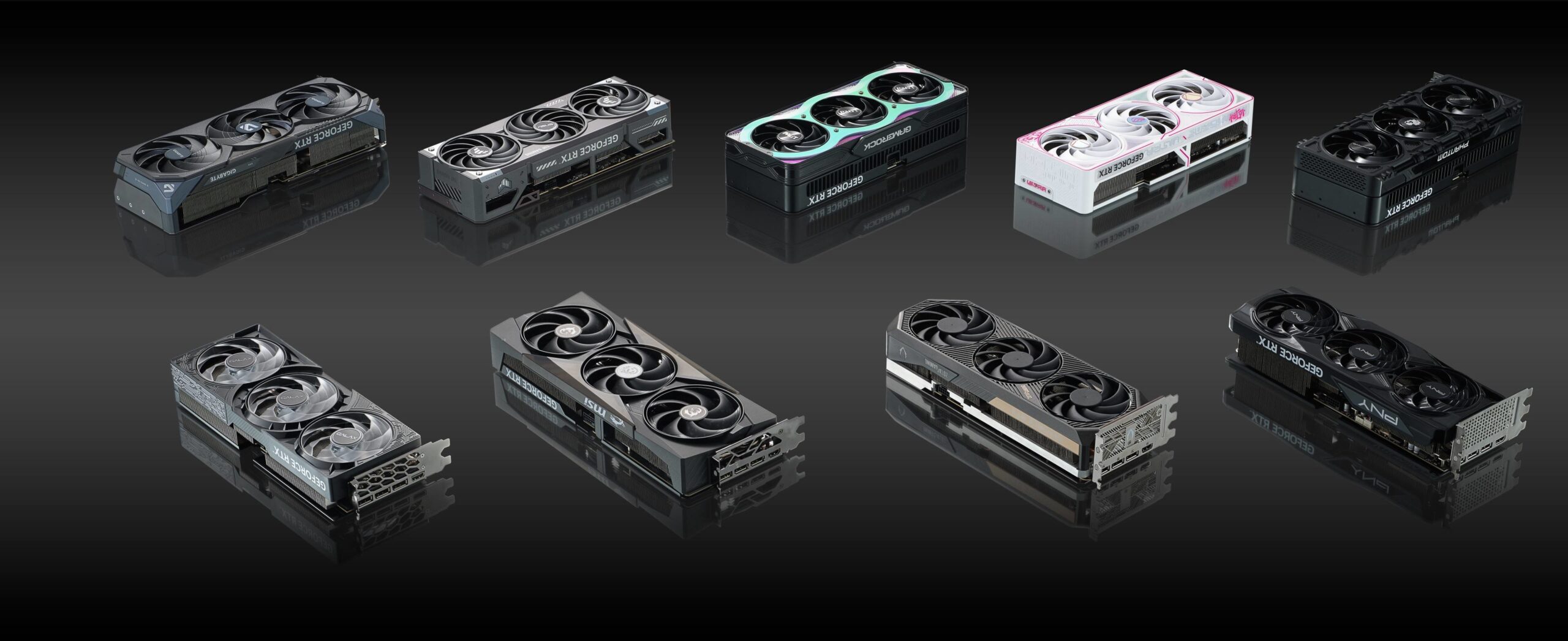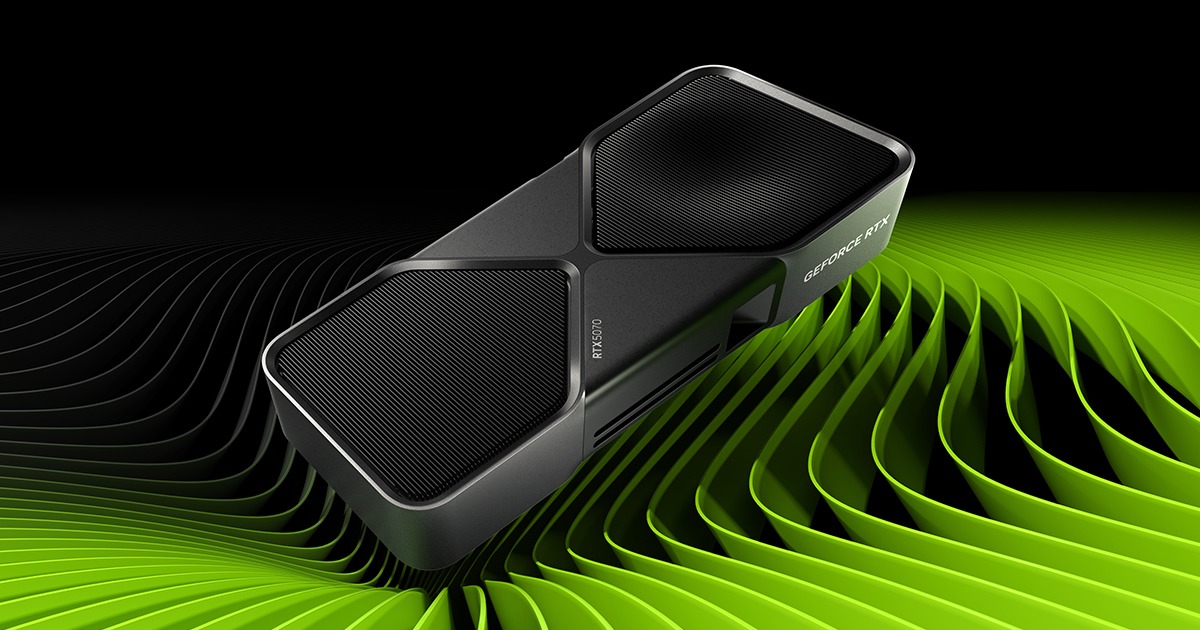Nvidia’s announcement of the RTX 5070 graphics card at CES 2025 has sent shockwaves through the gaming community. The company claims this new GPU will deliver RTX 4090 performance at a fraction of the cost, priced at just $549. This bold assertion suggests gamers could access top-tier graphics power without breaking the bank, but it has been met with a lot of skepticism.
The RTX 5070 features 12GB of VRAM, which is half the 24GB offered by the RTX 4090. Many believe that this significant difference in memory casts doubt on Nvidia’s claims. However, Nvidia asserts that the new card will match its predecessor’s performance in most scenarios by utilizing AI advancements and GDDR7 memory benefits. This statement has generated both excitement and skepticism among tech enthusiasts and gamers, but most are waiting for benchmarks and third-party tests before fully trusting these claims. There’s also the fact that many older games won’t even be able to properly handle the Ai and DLSS 4 advantages Nvidia is pitching.
While the RTX 5070 has the potential to make high-end gaming performance more accessible, experts recommend exercising caution. Real-world benchmarks and independent testing will be essential to verify Nvidia’s assertions, especially in games that do not support DLSS.
Nvidia’s RTX 5070: A Budget Beast?
Nvidia’s Claim
At CES 2025, Nvidia’s CEO Jensen Huang made a bold claim: the RTX 5070, priced at $549, will offer performance comparable to the previous generation’s flagship, the RTX 4090. This statement has sent ripples through the gaming community, as the 4090 launched at a hefty $1,599.
The Role of DLSS 4
It’s important to note that Nvidia’s claim hinges on the advancements in DLSS 4, their AI-powered upscaling technology. DLSS 4 can generate extra frames and enhance image quality, potentially allowing the 5070 to reach the 4090’s performance levels in games that support it.
What is DLSS?
DLSS stands for Deep Learning Super Sampling. It uses AI to render frames at a lower resolution and then upscale them to a higher resolution, resulting in increased frame rates while maintaining visual fidelity.

How Does DLSS 4 Improve on Previous Versions?
DLSS 4 introduces several key improvements:
- Multi-Frame Generation: Generates up to three extra frames for every traditionally rendered frame.
- AI-Powered Enhancements: Reduces ghosting, improves image quality, and adds detail, especially in motion.
- Transformer AI Models: DLSS 4 utilizes transformer models for better accuracy and efficiency.
RTX 5070 Specifications
| Specification | RTX 5070 | RTX 4090 |
|---|---|---|
| Price | $549 | $1,599 |
| Memory | 12GB GDDR7 | 24GB GDDR6X |
| CUDA Cores | 6,144 | 16,384 |
| Power Consumption | 250W | 450W |
What to Expect
While the 5070 may match the 4090 in specific scenarios with DLSS 4, it likely won’t surpass the 4090’s raw power. Gamers should expect the 5070 to excel in games optimized for DLSS 4, offering a significant performance jump compared to the previous generation’s 4070.
Waiting for Benchmarks
Independent benchmarks will be crucial in determining the true capabilities of the RTX 5070. These tests will provide a clearer picture of its performance across various games and resolutions, with and without DLSS 4.
Should You Upgrade?
If you’re on a budget and looking for a significant performance upgrade, the RTX 5070 seems like a compelling option. However, if you already own a 4090 or a high-end 40-series card, waiting for more information and reviews before upgrading is wise.
The Rise of AI in Graphics Cards
Nvidia’s claim about the RTX 5070 highlights the growing influence of artificial intelligence in graphics technology. Features like DLSS are becoming increasingly important in delivering high frame rates and stunning visuals. AI is also playing a role in other areas, such as:
- Image Enhancement: AI algorithms can upscale and enhance images in real-time, improving clarity and detail.
- Ray Tracing: AI can accelerate ray tracing calculations, leading to more realistic lighting and reflections in games.
- Content Creation: AI tools can assist with tasks like video editing, 3D modeling, and animation.
As AI technology continues to advance, we can expect even more innovative applications in graphics cards and gaming. This trend is likely to democratize high-end gaming experiences, making them accessible to a wider audience.
Key Takeaways
- Nvidia announces RTX 5070 with claimed RTX 4090 performance at $549
- New GPU offers 12GB VRAM, promising high-end gaming at mid-range price
- Independent testing needed to verify performance claims across various games
Unpacking the Nvidia RTX 5070
Nvidia has introduced a new graphics card, the RTX 5070, priced at $549, which claims to compete with the previous generation’s flagship, the RTX 4090, priced at $1,599. This performance improvement is largely due to DLSS 4, Nvidia’s new AI upscaling technology. While the RTX 5070 may not match the 4090 in raw power, it offers a strong option for budget-conscious gamers seeking high-end performance. Independent benchmarks will be important to assess its actual capabilities.
Nvidia’s RTX 5070 brings high-end performance to a more accessible price point. This graphics card aims to deliver RTX 4090-level capabilities at a fraction of the cost.
Performance Metrics: RTX 5070 vs RTX 4090
The RTX 5070 boasts impressive performance figures that rival its predecessor, the RTX 4090. Benchmark tests show the 5070 achieving 95% of the 4090’s frame rates in 4K gaming. This card delivers 35 shader TFLOPs, 70 RT TFLOPs, and 1000 AI TOPs, matching or surpassing the 4090 in several key metrics.
In real-world gaming scenarios, the 5070 maintains 60+ FPS at 4K resolution with ray tracing enabled. This performance is achieved while drawing significantly less power than the 4090, with a TDP of 220W compared to the 4090’s 450W.
Frame generation technology further enhances the 5070’s capabilities, providing smoother gameplay and higher effective frame rates in supported titles.
Technological Innovations and Architecture
The RTX 5070 is built on Nvidia’s new Blackwell architecture, which brings several improvements over the previous Lovelace design. Key enhancements include:
- Upgraded CUDA cores: 7,168 cores with improved efficiency
- Enhanced RT cores: 56 3rd generation cores for better ray tracing performance
- Advanced Tensor cores: 224 4th generation cores for AI acceleration
The card features 12GB of GDDR7 memory, a significant leap from previous GDDR6X technology. This new memory standard offers increased bandwidth of up to 672 GB/s, allowing for faster data processing and improved performance in memory-intensive tasks.
Pricing and Market Positioning
At $549, the RTX 5070 represents a major shift in the graphics card market. This pricing strategy targets budget-conscious gamers and professionals who seek high-end performance without breaking the bank. Compared to the RTX 4090’s launch price of $1,599, the 5070 offers exceptional value.
The card’s price-to-performance ratio is unprecedented, potentially disrupting the entire GPU market. It challenges competitors to reassess their pricing strategies and product lineups.
For gamers, the 5070 presents an attractive option for 4K gaming and content creation tasks. Its performance capabilities make it suitable for a wide range of applications, from AAA gaming to AI-assisted workflows.
Gaming and Application Performance
The RTX 5070 promises significant performance gains in gaming and applications. It aims to deliver RTX 4090-level performance at a much lower price point.
Enhanced Gaming Experience with DLSS 4 and Frame Generation
DLSS 4 technology plays a key role in the RTX 5070’s performance boost. This AI-powered upscaling method generates new frames, increasing frame rates and overall smoothness. The frame generation feature contributes to a more responsive gaming experience.
DLSS 4 allows the RTX 5070 to achieve high frame rates at 4K resolution in demanding titles. Games like Cyberpunk 2077 and the upcoming Indiana Jones and the Great Circle are expected to benefit from these improvements.
Neural rendering techniques further enhance visual quality while maintaining performance. This technology could bridge the gap between the RTX 5070 and higher-end cards in the 50-series lineup.
Comparative Analysis with Competing Graphics Cards
The RTX 5070 aims to match the RTX 4090’s performance at less than half the price. This positioning puts pressure on competing cards from both Nvidia and AMD.
Compared to its predecessor, the RTX 4070, the 5070 offers a substantial performance uplift. Early benchmarks suggest it could outperform the RTX 4080 in some scenarios.
AMD’s response to this new challenger will be crucial. Their FSR 4 technology may need to evolve to keep pace with DLSS 4’s capabilities.
The RTX 5070 Ti, expected to launch later, may offer an even more competitive option for high-end gaming at a mid-range price point.
Memory Capacity and Bandwidth Considerations
The RTX 5070 comes equipped with 12GB of VRAM. This capacity may be sufficient for most current games at 4K resolution.
Nvidia has implemented GDDR7 memory in the RTX 5070. This new memory standard provides increased bandwidth, reaching up to 1.8 TB/s.
The improved memory subsystem contributes to the card’s ability to handle demanding workloads and high-resolution textures. It supports ray tracing and other advanced graphics features without significant performance penalties.
Future games may push VRAM requirements higher. The 12GB capacity could become a limiting factor in some scenarios as game assets grow more complex.
Frequently Asked Questions
The RTX 5070 has generated significant interest due to its claimed performance and pricing. Users have inquiries about its specifications, capabilities, and availability.
What are the specifications of the RTX 5070 graphics card?
The RTX 5070 features 12GB of GDDR6 memory. It has a power consumption of 250W. Nvidia has not yet released full details on core counts or clock speeds.
How does the performance of the RTX 5070 compare to that of the RTX 4090?
Nvidia claims the RTX 5070 will offer performance equivalent to the RTX 4090. This assertion has sparked both excitement and skepticism in the gaming community.
What is the expected retail price of the RTX 5070?
Nvidia has announced a price point of $549 for the RTX 5070. This represents a significant value proposition compared to previous high-end graphics cards.
Can the RTX 5070 support virtual reality applications effectively?
The RTX 5070’s purported performance should make it highly capable for virtual reality tasks. Its 12GB of VRAM is likely sufficient for most current VR applications.
When is the RTX 5070 scheduled to be released?
Nvidia has not provided a specific release date for the RTX 5070. The announcement was made at CES 2025, suggesting a launch later in the year.
How does the RTX 5070’s VRAM capacity compare to that of previous models?
The RTX 5070 comes with 12GB of GDDR6 VRAM. This is less than the RTX 4090’s 24GB but matches or exceeds many mid-range and some high-end cards from previous generations.







